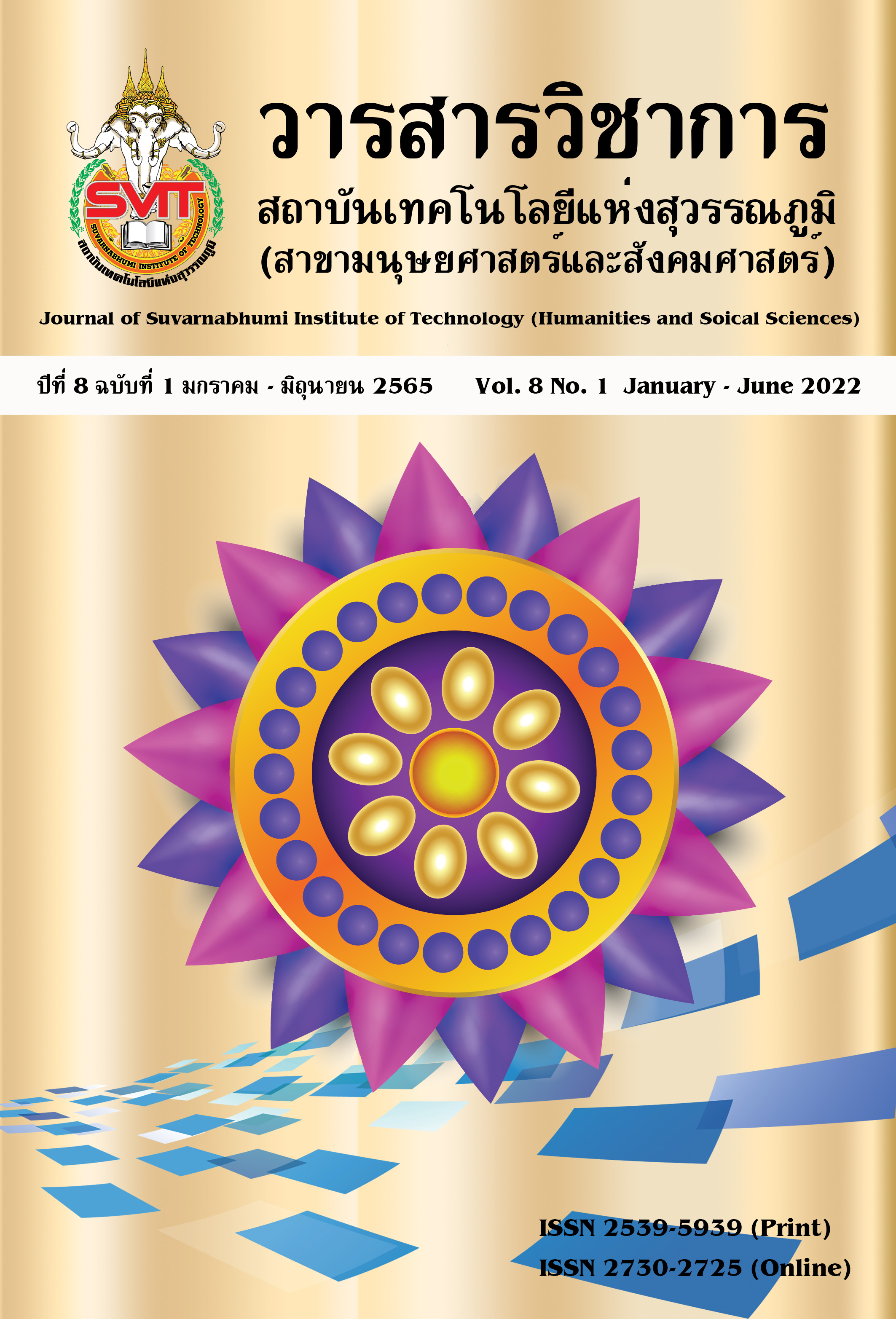THE DEVELOPMENT OF STUDENTS-TEACHERS RELATIONSHIP TEST OF UNDERGRADUATE STUDENTS
Keywords:
Student-teacher relationships, Relationships test, Undergraduate studentsAbstract
The purposes of this research were: 1) to develop student-teacher relationships test of undergraduate students 2) to check the quality of achievement of student-teacher relationships test of undergraduate students and 3) to create norms of student-teacher relationships test of undergraduate students. The data gathering consisted of 820 second year undergraduate students of regular program, faculty of Education from Northeastern group of Rajabhat Universities. Research instrument was student-teacher relationships test. Data were analyzed by using; item discrimination, correlation, reliability by Cronbach's alpha coefficient, content validity by index of item-objective congruence (IOC), exploratory factor analysis, confirmatory factor analysis, measurement model validity by both model fit indexes and construct validity, and T-test.
Results found that;
- Relationship test among student through teacher of undergraduates from the study analyzed by the theory factors concept and focus group between student and teacher could be consisted of 6 factors; teaching behavior, esteem, conflict, helpfulness, closeness and emotion which were included 32 items
- Quality of relationship test among student through teacher, the results showed that discrimination index was ranged between 0.21 – 0.72, reliability was between .90-.91 and reliability of entire was measured 0.91 and constructive validity with confirmatory factor analysis found valid test with 32 items and 6 factors according to construct validity examination of a standard model since 0.793 – 0.926 of undergraduates which had been passed at a good level.
- Creating norms of relationship test among student through teacher of undergraduates had raw scores during 43-160 points and T- test scores also had during 6-88
References
ทัศนา ทองภักดี. (2553). ความสัมพันธ์ระหว่างประสบการณ์ในมหาวิทยาลัยกับบุคลิกภาพของนิสิตปริญญาตรี มหาวิทยาลัยศรีนครินทรวิโรฒ ประสานมิตร (รายงานวิจัย). กรุงเทพมหานคร: มหาวิทยาลัย ศรีนครินทรวิโรฒ.
บุญเชิด ภิญโญอนันตพงษ์. (2545). ประมวลสาระชุดวิชาการพัฒนาเครื่องมือสำหรับการประเมินผลการศึกษา (หน่วยที่ 3). กรุงเทพฯ: มหาวิทยาลัยสุโขทัยธรรมาธิราช.
ยุทธ ไกยวรรณ์. (2551). สถิติเพื่อการวิจัย. กรุงเทพฯ: บริษัทพิมพ์ดีจำกัด.
ล้วน สายยศ, และอังคณา สายยศ. (2543). เทคนิคการวัดผลการเรียนรู้ (พิมพ์ครั้งที่ 2). กรุงเทพฯ: สุวีริยสาส์น.
วัชรินทร์ สุทธิศัย, และคณะ. (2555). ปัจจัยที่มีผลต่อความสำเร็จในการนำนโยบายมหาวิทยาลัยราชภัฏไปปฏิบัติ : กรณีศึกษามหาวิทยาลัยราชภัฏ กลุ่มภาคตะวันออกเฉียงเหนือ (ปริญญานิพนธ์ปริญญาดุษฏีบัณฑิต). กรุงเทพฯ: วิทยาลัยบัณฑิตศึกษาด้านการจัดการ มหาวิทยาลัยศรีปทุม.
สมนึก ภัททิยธนี. (2541). การวัดผลการศึกษา (พิมพ์ครั้งที่ 2). กาฬสินธุ์: ประสานการพิมพ์.
สมใจ วินิจกุล. (2552). ความสัมพันธ์ระหว่างความสามารถในการเรียนรู้ ความพึงพอใจกับความสุขในการเรียนรู้รายวิชาการพยาบาลอนามัยชุมชนของนักศึกษาพยาบาล วิทยาลัยพยาบาลเกื้อการุณย์. วารสารเกื้อการุณย์.
สำนักงานคณะกรรมการการอุดมศึกษา. (2560). สารสนเทศอุดมศึกษา. สืบค้น 26 เมษายน 2565, จาก http://www/info.mua.go.th/
สุพัตรา ผลรัตนไพบูลย์. (2550). ปัจจัยที่ส่งผลต่อพฤติกรรมการเรียนวิชาคณิตศาสตร์ของนักเรียนช่วงชั้นที่ 3 โรงเรียนสุราษฎร์พิทยา จังหวัดสุราษฎร์ธานี (วิทยานิพนธ์ปริญญามหาบัณฑิต). กรุงเทพฯ: บัณฑิตวิทยาลัย มหาวิทยาลัยศรีนครินทรวิโรฒ.
สุภมาส อังศุโชติ, สมถวิล วิจิตรวรรณา, และรัชนีกูล ภิญโญภานุวัฒน์. (2552). สถิติวิเคราะห์สำหรับการวิจัยทางสังคมศาสตร์และพฤติกรรมศาสตร์: เทคนิคการใช้โปรแกรม LISREL (พิมพ์ครั้งที่ 2). กรุงเทพฯ: เจริญดีมั่นคงการพิมพ์.
สุรีพร อนุศาสนนันท์ม. (2550). การเปรียบเทียบคุณภาพของการกำหนดมาตรฐานระหว่างวิธีแองกอฟที่ได้รับการปรับปรุงกับวิธีบุ๊คมาร์ค (ปริญญานิพนธ์ปริญญาดุษฎีบัณฑิต). กรุงเทพฯ: จุฬาลงกรณ์มหาวิทยาลัย.
Field, J. (2004). Psycholinguistics: The Key Concepts. London: Routledge.
Gable, Robert K. (1986). Instrument development in the affective domain. Boston. MA: Kluwer–Nijhoff.
Hair, J.F., Anderson, R.E., Tatham, R.L., & Black, W.C. (1998). Multivariate Data Analysis (5th ed). Upper Saddle River, NJ: Prentice Hall.
Koome, H.Y.M., F.C. (2015). Can closeness, conflict, and dependency be used to characterize students perceptions of the affective relationship with their teacher? Testing a new child measure in middle childhood.
May, T. (1997). Social Research: Issue, Methods and Process. Open University Press, Buckingham.
Nunnally, J. C. (1967). Psychometric Theory. New York: McGraw-Hill.
Schumacker, R.E. & Lomax, R.G. (1996). A beginner’s guide to structural equation Modeling. Mahwah, NJ: Lawrence Erlbaum.
Downloads
Published
Issue
Section
License
Copyright (c) 2022 Suvarnabhumi Institute of Technology

This work is licensed under a Creative Commons Attribution-NonCommercial-NoDerivatives 4.0 International License.
บทความที่ได้รับการตีพิมพ์เป็นลิขสิทธิ์ของวารสารวิชาการ สถาบันเทคโนโลยีแห่งสุวรรณภูมิ
ข้อความที่ปรากฏในบทความแต่ละเรื่องในวารสารวิชาการเล่มนี้เป็นความคิดเห็นส่วนตัวของผู้เขียนแต่ละท่านไม่เกี่ยวข้องกับสถาบันเทคโนโลยีแห่งสุวรรณภูมิ และคณาจารย์ท่านอื่นๆในสถาบันฯ แต่อย่างใด ความรับผิดชอบองค์ประกอบทั้งหมดของบทความแต่ละเรื่องเป็นของผู้เขียนแต่ละท่าน หากมีความผิดพลาดใดๆ ผู้เขียนแต่ละท่านจะรับผิดชอบบทความของตนเองแต่ผู้เดียว





